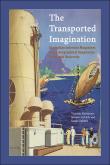 4381588445028271545.jpg
4381588445028271545.jpg
 The Transported Imagination : Australian Interwar Magazines and the Geographical Imaginaries of Colonial Modernity
multi chapter work
The Transported Imagination : Australian Interwar Magazines and the Geographical Imaginaries of Colonial Modernity
multi chapter work
 4381588445028271545.jpg
4381588445028271545.jpg
 The Transported Imagination : Australian Interwar Magazines and the Geographical Imaginaries of Colonial Modernity
multi chapter work
The Transported Imagination : Australian Interwar Magazines and the Geographical Imaginaries of Colonial Modernity
multi chapter work
'In the early twentieth century, new technologies of media, communication, and transportation opened up a world of possibilities and led to transformations of the public sphere. Amongst the hundreds of new periodicals flooding the Australian marketplace, quality culture and leisure magazines beckoned to readers with the glamour of modernity and exotic images of pre-modern paradise. Through instructive and entertaining content, these glossy modern magazines widened the horizons of non-metropolitan audiences and connected readers in rapidly urbanising cities such as Sydney and Melbourne with the latest fashions, current affairs, and cultural offerings of London, Paris, New York, Los Angeles, and beyond. Designed by fashionable commercial artists, travel advertisements for shipping companies such as Burns Philp, Cunard, Matson, and P&O lined their pages. The golden age of the culture and leisure magazine coincided with the golden age of sea travel, middlebrow aspiration, and modernity.
'Focusing on the Australian interwar periodicals The Home, The BP Magazine, and MAN, this book explores the contraction of vast geographical spaces and the construction of cultural hierarchies alongside the advent of new media. This book investigates the role tastemaking culture and leisure magazines played in transporting the public imagination outward beyond the shores of Australia and upward or downward on the rapidly changing scales of cultural value. By delivering a potent mix of informative instruction, entertainment, worldliness, and escape, these magazines constructed distinct geographical imaginaries connected to notions of glamour, sophistication, and aspiration. They guided their readers through the currents of international modernity and helped them find their place in the modern world.
'This book is based on thorough research into an archive of important yet under-examined modern Australian periodicals, and makes a significant contribution to the scholarly literature on magazines and middlebrow culture in the interwar period. It offers new insights into the formation of the tastes of a rapidly modernising and differentiating reading public, as well as new understandings of the cultures of vernacular modernity and colonialism. This book also offers alternative perspectives, and positions Australia’s cultural and literary history within transnational cultural flows across the Indian and Pacific Oceans. Its analysis of Australian colonial modernity thus provides a model for examining collisions of modernity and colonialism, and for investigating connections between geographical imaginaries and social mobility, in other international contexts.'
Source: Publisher's blurb.
Table of contents:
Introduction: A Door to the World
Part One: Geography
Chapter 1: International Affairs
Chapter 2: Non-Fiction Travel Features
Chapter 3: Fashion and Advertising
Part Two: Cultural Value
Chapter 4: Authors and Artists
Chapter 5: Book and Film Reviews
Part Three: Temporality
Chapter 6: Currents of Fiction
Chapter 7: Pacific Travellers
Conclusion: Points of Disembarkation
(Publication abstract)
'The Transported Imagination, an elegantly presented offering from Victoria Kuttainen, Susann Liebich and Sarah Galletly, explores the intersecting themes of modernity, colonialism, glamour and travel in three ‘culture and leisure’ magazines in interwar Australia. Through their engagement with the varied content of Home (1920–42), The BP Magazine (1928–42) and MAN (1936–72), the authors argue that representations of travel functioned as a means for these magazines to both construct and negotiate what it meant to be modern in interwar Australia, particularly at a time where, they argue, ‘the Pacific was at the fore of the nation's consciousness and imagination’ (18). Organised across three parts – Geography, Cultural Value, and Temporality – the book endeavours to show that it was not just physical travel that was so crucial to interwar ideas of modernity but imagined travel as well. Indeed, the authors engage with the concept of ‘geographical imaginary’ and the ‘outward gaze’ to contend that, as cultural texts, magazines enabled readers to forge a connection to a world beyond Australian shores and understand themselves as on the cutting edge of global fashion, cinematic, literary, and artistic trends – even if they never left their armchairs.' (Introduction)
'The Transported Imagination, an elegantly presented offering from Victoria Kuttainen, Susann Liebich and Sarah Galletly, explores the intersecting themes of modernity, colonialism, glamour and travel in three ‘culture and leisure’ magazines in interwar Australia. Through their engagement with the varied content of Home (1920–42), The BP Magazine (1928–42) and MAN (1936–72), the authors argue that representations of travel functioned as a means for these magazines to both construct and negotiate what it meant to be modern in interwar Australia, particularly at a time where, they argue, ‘the Pacific was at the fore of the nation's consciousness and imagination’ (18). Organised across three parts – Geography, Cultural Value, and Temporality – the book endeavours to show that it was not just physical travel that was so crucial to interwar ideas of modernity but imagined travel as well. Indeed, the authors engage with the concept of ‘geographical imaginary’ and the ‘outward gaze’ to contend that, as cultural texts, magazines enabled readers to forge a connection to a world beyond Australian shores and understand themselves as on the cutting edge of global fashion, cinematic, literary, and artistic trends – even if they never left their armchairs.' (Introduction)
(Publication abstract)